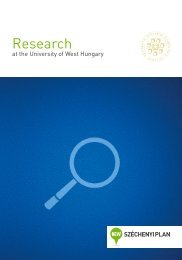Facskó Ferenc (szerk.) (2012): Kutatások a Nyugat-magyarországi
Facskó Ferenc (szerk.) (2012): Kutatások a Nyugat-magyarországi
Facskó Ferenc (szerk.) (2012): Kutatások a Nyugat-magyarországi
Create successful ePaper yourself
Turn your PDF publications into a flip-book with our unique Google optimized e-Paper software.
<strong>Kutatások</strong> a <strong>Nyugat</strong>-<strong>magyarországi</strong> Egyetemen<br />
Publikációk:<br />
FARKAS Ágnes – NAGY TÓTH Erika – KÓSA Géza (2010): Madárbirs (Cotoneaster) fajok<br />
nektárium-<strong>szerk</strong>ezete. XIV. Apáczai Napok Tanulmánykötete, Győr 912-919.old.<br />
Összefoglaló – A fenti összefüggés alapján a vizsgált madárbirsek közül várhatóan nagy<br />
nektárhozamú, a méheket erősen vonzó, tehát a méhészet céljára ajánlható fajok a C.<br />
conspicuus, a C. nanshan és a C. monopyrenus. Kisebb nektárprodukció, és ezzel összefüggésben<br />
gyengébb méhvonzás várható a kisebb és vékonyabb mirigyű fajoktól, mint pl. a C.<br />
laxifl orus, C. lucidus és C. saxatilis. Bár utóbbiaknak a méhészeti értéke kisebb lehet, éppen<br />
a környezetükben várható kisebb méhsűrűség miatt ezek a fajok alkalmasabbak arra, hogy<br />
kertekbe, gyümölcsösök közelébe ill. közterületekre ültessük őket.<br />
Eredményeink összegzéseképpen megállapíthatjuk, hogy:<br />
• a madárbirs (Cotoneaster) fajok nektáriuma automorf és receptakuláris<br />
• a nektáriumsztómák mezo- vagy xeromorf típusúak<br />
• a glanduláris szövet 3-4 sejtsoros<br />
• a nektáriumparenchimában gyakoriak a kalcium-oxalát rozetták<br />
• a mirgyek rendelkeznek nyalábellátottsággal<br />
• az egyes fajok nektáriummérete és -vastagsága egymástól szignifi kánsan különbözhet<br />
• a különböző fajok nektártermelésében, így méhvonzásában is eltéréseket tapasztalhatunk.<br />
Erika NAGY TOTH – Rita FILEP – Agnes FARKAS (2011): Nectary structure of Cotoneaster<br />
roseus. Acta Biologica Szegediensis Volume 55(2)<br />
Abstract – Cotoneasters are widely planted as ornamentals, which at the same time can<br />
serve as a source of nectar for honey bees and bumble bees. The present study gives a detailed<br />
description of the nectary anatomy of Cotoneaster roseus. The fl oral nectary is located<br />
within the receptacle, with well distinguishable regions of the epidermis, glandular<br />
tissue and nectary parenchyma. Modifi ed nectary stomata are at level with or below the epidermis;<br />
the glandular cells are arranged in 3 to 4 subepidermal layers; and calcium oxalate<br />
crystals are typical in the nectary parenchyma. Data are provided on the size and thickness<br />
of the nectar gland, which can be signifi cant factors determining the nectar producing ability<br />
of the fl owers.<br />
Ágnes FARKAS – Erika NAGY TÓTH (<strong>2012</strong>): Nectar secretion dynamics and insect attraction<br />
of some Cotoneaster species. 2 nd Global Congress on Plant Reproductive Biology (PRB-<br />
<strong>2012</strong>)<br />
Abstract – Cotoneaster species (Rosaceae, Maloideae) are well-known ornamentals, widespread<br />
in the temperate regions of Europe and Asia. Although their fl owers are small, they<br />
can provide large volumes of nectar with high sugar concentrations, which features make<br />
them attractive for honey bees (Apis mellifera) and bumble bees (Bombus sp.). However, the<br />
nectar producing capacity of diff erent species may vary to a large extent. Our investigation<br />
aimed at clarifying which species are the best nectar producers and the most attractive for<br />
pollinators. Another goal of the research was to identify characteristic nectar secretion patterns<br />
in various cotoneasters.<br />
The present study included 6 Cotoneaster species, investigated in the Botanical Garden in<br />
Vácrátót, Hungary, between 25 and 27 May 2011. In order to determine daily nectar production,<br />
fl owers were sampled following a period of 24-hour isolation by a tulle net. To<br />
study nectar secretion dynamics, 20 fl owers per species were tagged, and the same fl owers<br />
were sampled every 2 hours between 8:00 and 18:00 h. Nectar volume was determined with<br />
210



